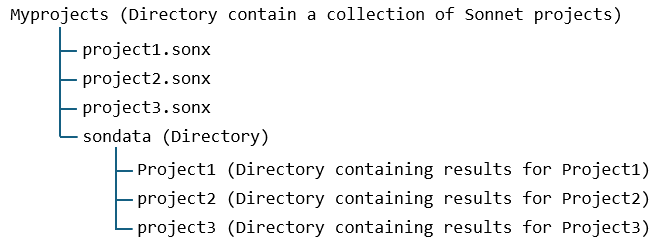Sessions and Projects
Sonnet Session
When you invoke Sonnet, you start a Session. A Sonnet Session defines what what Sonnet modules (tabs) are open, and how the tabs are configured. You may only have one Session running at a time but there is no limit on the number windows and tabs, nor on the number of open projects. The Session panel, which appears in every type of Sonnet tab, including the default Session tab, allows you to keep track of every tab and project that is open in the present Session.
By default, when you open Sonnet, your previous Session is automatically loaded. If you wish, you can also save a Session in a Session File (.sesn) for later use by selecting File > Session > Save Session from the Session tab. A Session File stores the following information:
- The tabs that are open
- The projects that are open and in which tabs
- The window configurations of the tabs, including placement of panels and toolbars
- Graphs and all their settings
The Session saves pointers to projects but not the actual project content.
Sonnet Projects
There are two types of projects in Sonnet: the Geometry project and the Netlist project.
- Geometry project: The most common type of project is the Geometry project, and a majority of the documentation concerns the input and analysis of this type of project. The Geometry project contains the layout, material properties, frequency sweeps, and any other information required to perform the EM analysis.
- Netlist project: A Netlist Project contains a circuit defined by a netlist which consists of one or more networks with elements, which can be Geometry projects, data files, or lumped elements, connected together. A network is defined which connects any combination of these items together. A common use for a Netlist project is to connect two or more Geometry projects together. Sonnet uses circuit theory to analyze the network.
Directory Structure
When you save a Sonnet project, a file is created with a ".sonx" extension. In addition, a directory called sondata is created and a subdirectory within the sondata directory is created with the same name as the project name. This subdirectory contains the high-precision results of your EM solver simulations. This includes S-parameter data, current density data, and log information. The data is in a format that has been optimize for efficient reading by Sonnet and is not meant to be read by a typical user. If you wish to create a file that is in a more standard or easier to read format, see Output Files - Overview.
For example, the following picture shows the directory structure that would result from saving three Sonnet projects into a working directory called myprojects.

You may also place other files into your working directory, including Sonnet output files and non-Sonnet files. However, you should not place additional files in the sondata directory.